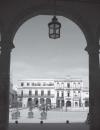Resumen
En el presente trabajo se exponen algunas experienciasy consideraciones sobre Cartagena de Indias y La Habana,dos importantes conjuntos urbanos ubicados en el área geográficadel Caribe y que, desde muy temprano en el siglo XVII,estuvieron estrechamente relacionados por el hecho históricoy económico de constituir, ambos puertos, puntos deescala obligada, en los recorridos hacia la Metrópoli, de lasflotas de los galeones, que trasladaban las riquezas extraídasde estos territorios desde las posesiones españolas enel Nuevo Mundo. El origen hispánico y la permanencia deesta raíz, tanto en Cuba como en Colombia, durante más detres siglos de colonización, comenzaron a gestar y a desarrollaraspectos que en la actualidad permanecen como elementostestimoniales de un origen común. La importancia estratégica de la región del Caribe, puerta marítima de entraday salida obligada hacia todo el resto del continente, laconvirtió en una codiciada y neurálgica área de conflicto entrelas potencias que, en aquellos tiempos, se disputaban lasupremacía y el dominio de los mares. Así mismo, fue tomadacon gran consideración desde los primeros momentospor España, que decidida a mantener su dominio y controlmilitar de esta área, propone el estudio y la ejecución de unsistema defensivo regional para su protección. De esta formase edificó un grupo notable de fortificaciones en todo elentorno insular y continental.La revista Apuntes se encuentra registrada bajo la licencia Creative Commons Reconocimiento 4.0 Internacional. Por lo tanto, esta obra se puede reproducir, distribuir y comunicar públicamente en formato digital, siempre que se reconozca el nombre de los autores y a la Pontificia Universidad Javeriana. Se permite citar, adaptar, transformar, autoarchivar, republicar y crear a partir del material, para cualquier finalidad (incluso comercial), siempre que se reconozca adecuadamente la autoría, se proporcione un enlace a la obra original y se indique si se han realizado cambios. La Pontificia Universidad Javeriana no retiene los derechos sobre las obras publicadas y los contenidos son responsabilidad exclusiva de los autores, quienes conservan sus derechos morales, intelectuales, de privacidad y publicidad.
El aval sobre la intervención de la obra (revisión, corrección de estilo, traducción, diagramación) y su posterior divulgación se otorga mediante una licencia de uso y no a través de una cesión de derechos, lo que representa que la revista y la Pontificia Universidad Javeriana se eximen de cualquier responsabilidad que se pueda derivar de una mala práctica ética por parte de los autores. En consecuencia de la protección brindada por la licencia de uso, la revista no se encuentra en la obligación de publicar retractaciones o modificar la información ya publicada, a no ser que la errata surja del proceso de gestión editorial. La publicación de contenidos en esta revista no representa regalías para los contribuyentes.


